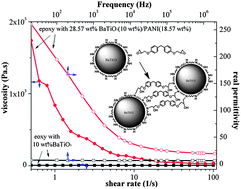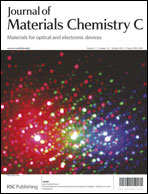Polyaniline stabilized barium titanate nanoparticles reinforced epoxy nanocomposites with high dielectric permittivity and reduced flammability†
Abstract
Epoxy polymer nanocomposites (PNCs) filled with both barium titanate (BaTiO3) (500 and 100 nm) and conductive polyaniline (PANI) stabilized BaTiO3 nanoparticles (NPs) have been successfully prepared. The effects of the BaTiO3 nanofiller loading level and the PANI coating on the mechanical properties, rheological behavior, thermal stability, flammability and dielectric properties were systematically studied. The viscosity study on the nanosuspensions indicates that the PANI layer on the BaTiO3 nanoparticle surface can promote the network formation of the epoxy resin. The introduction of the PANI layer was found to reduce the heat release rate and to increase the char residue of the epoxy resin. The dynamic storage and loss moduli were studied together with the glass transition temperature (Tg) obtained from the peak of tan δ, and the reduced Tg in the PNCs is associated with the enlarged free volume. The tensile test indicated an improved tensile strength of the epoxy matrix with the introduction of the BaTiO3 NPs. Compared with the cured pure epoxy, the elasticity modulus was increased for all the PNC samples. The fracture surface study revealed an enhanced toughness. Due to the ferroelectric nature of BaTiO3, the real dielectric permittivity increased with increasing the BaTiO3 nanoparticle loading. The PANI layer on the surface of BaTiO3 also enhanced the dielectric permittivity arising from the interfacial polarization formed in the PNCs.


 Please wait while we load your content...
Please wait while we load your content...